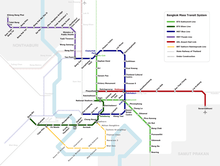MRT Blue Line
| Blue Line | |||||||||||||||||||||||||||||||||||||||||||||||||||||||||||||||||||||||||||||||||||||||||||||||||||||||||||||||||||||||||||||||||||||||||||||||||||||||||||||||||||||||||||||||||||||||||||||||||||||||||||||||||||||||||||||||||||||||||||||||||||||||||||||||||||||||||||||||||||||||||||||||||||||||||||||||||||||||||||||||||||||||||||||||||||||||||||||
|---|---|---|---|---|---|---|---|---|---|---|---|---|---|---|---|---|---|---|---|---|---|---|---|---|---|---|---|---|---|---|---|---|---|---|---|---|---|---|---|---|---|---|---|---|---|---|---|---|---|---|---|---|---|---|---|---|---|---|---|---|---|---|---|---|---|---|---|---|---|---|---|---|---|---|---|---|---|---|---|---|---|---|---|---|---|---|---|---|---|---|---|---|---|---|---|---|---|---|---|---|---|---|---|---|---|---|---|---|---|---|---|---|---|---|---|---|---|---|---|---|---|---|---|---|---|---|---|---|---|---|---|---|---|---|---|---|---|---|---|---|---|---|---|---|---|---|---|---|---|---|---|---|---|---|---|---|---|---|---|---|---|---|---|---|---|---|---|---|---|---|---|---|---|---|---|---|---|---|---|---|---|---|---|---|---|---|---|---|---|---|---|---|---|---|---|---|---|---|---|---|---|---|---|---|---|---|---|---|---|---|---|---|---|---|---|---|---|---|---|---|---|---|---|---|---|---|---|---|---|---|---|---|---|---|---|---|---|---|---|---|---|---|---|---|---|---|---|---|---|---|---|---|---|---|---|---|---|---|---|---|---|---|---|---|---|---|---|---|---|---|---|---|---|---|---|---|---|---|---|---|---|---|---|---|---|---|---|---|---|---|---|---|---|---|---|---|---|---|---|---|---|---|---|---|---|---|---|---|---|---|---|---|---|---|---|---|---|---|---|---|---|---|---|---|---|---|---|---|---|---|---|---|---|---|---|---|---|---|---|---|---|---|---|---|---|---|---|---|---|
|
| |||||||||||||||||||||||||||||||||||||||||||||||||||||||||||||||||||||||||||||||||||||||||||||||||||||||||||||||||||||||||||||||||||||||||||||||||||||||||||||||||||||||||||||||||||||||||||||||||||||||||||||||||||||||||||||||||||||||||||||||||||||||||||||||||||||||||||||||||||||||||||||||||||||||||||||||||||||||||||||||||||||||||||||||||||||||||||||
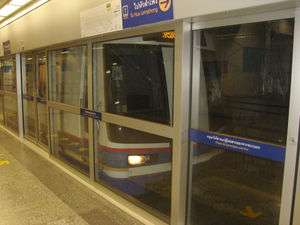 Train arriving at Si Lom Station | |||||||||||||||||||||||||||||||||||||||||||||||||||||||||||||||||||||||||||||||||||||||||||||||||||||||||||||||||||||||||||||||||||||||||||||||||||||||||||||||||||||||||||||||||||||||||||||||||||||||||||||||||||||||||||||||||||||||||||||||||||||||||||||||||||||||||||||||||||||||||||||||||||||||||||||||||||||||||||||||||||||||||||||||||||||||||||||
| Overview | |||||||||||||||||||||||||||||||||||||||||||||||||||||||||||||||||||||||||||||||||||||||||||||||||||||||||||||||||||||||||||||||||||||||||||||||||||||||||||||||||||||||||||||||||||||||||||||||||||||||||||||||||||||||||||||||||||||||||||||||||||||||||||||||||||||||||||||||||||||||||||||||||||||||||||||||||||||||||||||||||||||||||||||||||||||||||||||
| Native name | สายเฉลิมรัชมงคล | ||||||||||||||||||||||||||||||||||||||||||||||||||||||||||||||||||||||||||||||||||||||||||||||||||||||||||||||||||||||||||||||||||||||||||||||||||||||||||||||||||||||||||||||||||||||||||||||||||||||||||||||||||||||||||||||||||||||||||||||||||||||||||||||||||||||||||||||||||||||||||||||||||||||||||||||||||||||||||||||||||||||||||||||||||||||||||||
| Type | Heavy Rail | ||||||||||||||||||||||||||||||||||||||||||||||||||||||||||||||||||||||||||||||||||||||||||||||||||||||||||||||||||||||||||||||||||||||||||||||||||||||||||||||||||||||||||||||||||||||||||||||||||||||||||||||||||||||||||||||||||||||||||||||||||||||||||||||||||||||||||||||||||||||||||||||||||||||||||||||||||||||||||||||||||||||||||||||||||||||||||||
| System | MRT | ||||||||||||||||||||||||||||||||||||||||||||||||||||||||||||||||||||||||||||||||||||||||||||||||||||||||||||||||||||||||||||||||||||||||||||||||||||||||||||||||||||||||||||||||||||||||||||||||||||||||||||||||||||||||||||||||||||||||||||||||||||||||||||||||||||||||||||||||||||||||||||||||||||||||||||||||||||||||||||||||||||||||||||||||||||||||||||
| Locale | Bangkok | ||||||||||||||||||||||||||||||||||||||||||||||||||||||||||||||||||||||||||||||||||||||||||||||||||||||||||||||||||||||||||||||||||||||||||||||||||||||||||||||||||||||||||||||||||||||||||||||||||||||||||||||||||||||||||||||||||||||||||||||||||||||||||||||||||||||||||||||||||||||||||||||||||||||||||||||||||||||||||||||||||||||||||||||||||||||||||||
| Termini |
Tao Poon[1] Hua Lamphong | ||||||||||||||||||||||||||||||||||||||||||||||||||||||||||||||||||||||||||||||||||||||||||||||||||||||||||||||||||||||||||||||||||||||||||||||||||||||||||||||||||||||||||||||||||||||||||||||||||||||||||||||||||||||||||||||||||||||||||||||||||||||||||||||||||||||||||||||||||||||||||||||||||||||||||||||||||||||||||||||||||||||||||||||||||||||||||||
| Stations | 19[1] | ||||||||||||||||||||||||||||||||||||||||||||||||||||||||||||||||||||||||||||||||||||||||||||||||||||||||||||||||||||||||||||||||||||||||||||||||||||||||||||||||||||||||||||||||||||||||||||||||||||||||||||||||||||||||||||||||||||||||||||||||||||||||||||||||||||||||||||||||||||||||||||||||||||||||||||||||||||||||||||||||||||||||||||||||||||||||||||
| Operation | |||||||||||||||||||||||||||||||||||||||||||||||||||||||||||||||||||||||||||||||||||||||||||||||||||||||||||||||||||||||||||||||||||||||||||||||||||||||||||||||||||||||||||||||||||||||||||||||||||||||||||||||||||||||||||||||||||||||||||||||||||||||||||||||||||||||||||||||||||||||||||||||||||||||||||||||||||||||||||||||||||||||||||||||||||||||||||||
| Opened | 3 July 2004 | ||||||||||||||||||||||||||||||||||||||||||||||||||||||||||||||||||||||||||||||||||||||||||||||||||||||||||||||||||||||||||||||||||||||||||||||||||||||||||||||||||||||||||||||||||||||||||||||||||||||||||||||||||||||||||||||||||||||||||||||||||||||||||||||||||||||||||||||||||||||||||||||||||||||||||||||||||||||||||||||||||||||||||||||||||||||||||||
| Owner | Mass Rapid Transit Authority | ||||||||||||||||||||||||||||||||||||||||||||||||||||||||||||||||||||||||||||||||||||||||||||||||||||||||||||||||||||||||||||||||||||||||||||||||||||||||||||||||||||||||||||||||||||||||||||||||||||||||||||||||||||||||||||||||||||||||||||||||||||||||||||||||||||||||||||||||||||||||||||||||||||||||||||||||||||||||||||||||||||||||||||||||||||||||||||
| Operator(s) | Bangkok Expressway and Metro Public Company Limited | ||||||||||||||||||||||||||||||||||||||||||||||||||||||||||||||||||||||||||||||||||||||||||||||||||||||||||||||||||||||||||||||||||||||||||||||||||||||||||||||||||||||||||||||||||||||||||||||||||||||||||||||||||||||||||||||||||||||||||||||||||||||||||||||||||||||||||||||||||||||||||||||||||||||||||||||||||||||||||||||||||||||||||||||||||||||||||||
| Depot(s) | Phra Ram 9 | ||||||||||||||||||||||||||||||||||||||||||||||||||||||||||||||||||||||||||||||||||||||||||||||||||||||||||||||||||||||||||||||||||||||||||||||||||||||||||||||||||||||||||||||||||||||||||||||||||||||||||||||||||||||||||||||||||||||||||||||||||||||||||||||||||||||||||||||||||||||||||||||||||||||||||||||||||||||||||||||||||||||||||||||||||||||||||||
| Technical | |||||||||||||||||||||||||||||||||||||||||||||||||||||||||||||||||||||||||||||||||||||||||||||||||||||||||||||||||||||||||||||||||||||||||||||||||||||||||||||||||||||||||||||||||||||||||||||||||||||||||||||||||||||||||||||||||||||||||||||||||||||||||||||||||||||||||||||||||||||||||||||||||||||||||||||||||||||||||||||||||||||||||||||||||||||||||||||
| Line length | 21 km (13 mi) | ||||||||||||||||||||||||||||||||||||||||||||||||||||||||||||||||||||||||||||||||||||||||||||||||||||||||||||||||||||||||||||||||||||||||||||||||||||||||||||||||||||||||||||||||||||||||||||||||||||||||||||||||||||||||||||||||||||||||||||||||||||||||||||||||||||||||||||||||||||||||||||||||||||||||||||||||||||||||||||||||||||||||||||||||||||||||||||
| Number of tracks | 2 | ||||||||||||||||||||||||||||||||||||||||||||||||||||||||||||||||||||||||||||||||||||||||||||||||||||||||||||||||||||||||||||||||||||||||||||||||||||||||||||||||||||||||||||||||||||||||||||||||||||||||||||||||||||||||||||||||||||||||||||||||||||||||||||||||||||||||||||||||||||||||||||||||||||||||||||||||||||||||||||||||||||||||||||||||||||||||||||
| Track gauge | 1,435 mm (4 ft 8 1⁄2 in) | ||||||||||||||||||||||||||||||||||||||||||||||||||||||||||||||||||||||||||||||||||||||||||||||||||||||||||||||||||||||||||||||||||||||||||||||||||||||||||||||||||||||||||||||||||||||||||||||||||||||||||||||||||||||||||||||||||||||||||||||||||||||||||||||||||||||||||||||||||||||||||||||||||||||||||||||||||||||||||||||||||||||||||||||||||||||||||||
| Electrification | Third rail | ||||||||||||||||||||||||||||||||||||||||||||||||||||||||||||||||||||||||||||||||||||||||||||||||||||||||||||||||||||||||||||||||||||||||||||||||||||||||||||||||||||||||||||||||||||||||||||||||||||||||||||||||||||||||||||||||||||||||||||||||||||||||||||||||||||||||||||||||||||||||||||||||||||||||||||||||||||||||||||||||||||||||||||||||||||||||||||
| Operating speed | 80 km/h (50 mph) | ||||||||||||||||||||||||||||||||||||||||||||||||||||||||||||||||||||||||||||||||||||||||||||||||||||||||||||||||||||||||||||||||||||||||||||||||||||||||||||||||||||||||||||||||||||||||||||||||||||||||||||||||||||||||||||||||||||||||||||||||||||||||||||||||||||||||||||||||||||||||||||||||||||||||||||||||||||||||||||||||||||||||||||||||||||||||||||
| |||||||||||||||||||||||||||||||||||||||||||||||||||||||||||||||||||||||||||||||||||||||||||||||||||||||||||||||||||||||||||||||||||||||||||||||||||||||||||||||||||||||||||||||||||||||||||||||||||||||||||||||||||||||||||||||||||||||||||||||||||||||||||||||||||||||||||||||||||||||||||||||||||||||||||||||||||||||||||||||||||||||||||||||||||||||||||||
The MRT Chaloem Ratchamongkhon line (Thai: รถไฟฟ้ามหานคร สายเฉลิมรัชมงคล) or MRT Blue line (Thai: รถไฟฟ้ามหานคร สายสีน้ำเงิน) is the first of Bangkok's MRT system and the city's third rapid transit line, following the Sukhumvit line and Silom line of the BTS Skytrain. Opened on 3 July 2004,[2] it runs eastward from Tao Poon Station in Bang Sue District along Kamphaeng Phet, Phahon Yothin and Lat Phrao Roads, then turns south following Ratchadaphisek Road, then west following Rama IV Road to Hua Lamphong station in Pathum Wan District.
A much delayed 27 km extension to the Blue line finally began construction in mid-2011. It was originally due for completion in 2016 but the floods of 2011 added one year to the schedule. [3] The first section of the Blue Line extension from Hua Lamphong – Tha Phra – Lak Song is expected to open on 12 August 2019 with the full extension open by April 2020.[4] This will be over three years later than originally scheduled when construction started.
When completed the 48-km-long MRT Blue Line would form a quasi circle line encircling the core business and cultural areas of Bangkok and Thonburi.
History
For the Blue Line most civil infrastructure was provided by a new government agency, the Mass Rapid Transit Authority of Thailand (MRTA), and handed over to a private-sector operator for a 25-year concession agreement. The winning bidder was Bangkok Metro Company Limited (BMCL), subsequently renamed Bangkok Expressway and Metro Public Company Limited (BEM). BMCL/BEM provide maintenance & engineering equipment, including electrical trains, signalling systems, SCADA, communication, platform screen doors and fully operates the system. BMCL/BEM has subcontracted maintenance of the system for 10 years to Siemens and seven-year maintenance contracts to two local maintenance services.[5]
The construction of the first Bangkok Metro line, officially known as Chaloem Ratchamongkhon (Thai สายเฉลิมรัชมงคล) – "Celebration of Royal Auspice" – or informally as the "Blue Line", began on 19 November 1996. The project suffered multiple delays not only because of the 1997 economic crisis, but also due to challenging civil engineering works of constructing massive underground structures deep in the water-logged soil upon which the city is built.
The Blue line was opened for a limited public trial period of several weeks starting on 13 April 2004. On 3 July 2004 the line was officially opened at 19:19 local time by HM King Bhumibol and Queen Sirikit,[2] who were accompanied by other members of the royal family. Within 30 minutes of its opening, sightseers filled the system to its maximum capacity, but after the initial rush ridership settled down to around 180,000 riders daily — considerably lower than projections of over 400,000, despite fares being slashed in half from 12-38 baht to 10-15 baht per trip. By 2016, the average daily ridership was 273,637.[6] By September 2017, BEM stated that average daily ridership had increased to 360,000 after the opening of the extension to Tao Poon. [7]
Operation
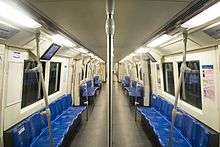
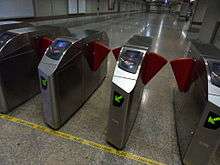
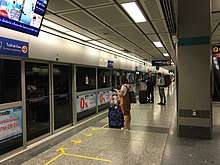
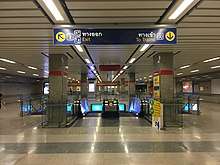
The 21-kilometre, 19-station Blue line presently runs from Tao Poon to Hua Lamphong via Phra Ram 9 and has a carrying capacity of 40,000 people in each direction per hour. Similar to the Skytrain, the Metro uses trains supplied by Siemens that travel at up to 80 km/h. Passengers can change to the Skytrain at Si Lom, Sukhumvit and Chatuchak Park stations. The metro has a large depot in Huai Khwang district, which is located between Phra Ram 9 and Thailand Cultural Centre stations.
Due to safety considerations, platform screen doors are installed. Uniformed security personnel and security cameras are present at each and every platform. Currently 19 three-car metro trains, of the Siemens Modular Metro type, are used. Each metro train consists of two motor cars and a centre trailer car.[8] Passenger announcements on this line are made by journalist and news broadcaster Sarocha Pornudomsak.
Stations
English |
Thai |
|||
|---|---|---|---|---|
| Tao Poon-Tha Phra Extension (under construction, scheduled to open 2 March 2020)[9] | ||||
| BL01 | Tha Phra | ท่าพระ | MRT (Hua Lamphong-Lak Song Extension, under construction) | Bangkok Yai |
| BL02 | Charan 13 | จรัญฯ 13 | ||
| BL03 | Fai Chai | ไฟฉาย | Bangkok Noi | |
| BL04 | Bang Khun Non | บางขุนนนท์ | MRT (planned) SRT (planned) | |
| BL05 | Bang Yi Khan | บางยี่ขัน | Bang Phlat | |
| BL06 | Sirindhorn | สิรินธร | ||
| BL07 | Bang Phlat | บางพลัด | ||
| BL08 | Bang O | บางอ้อ | ||
| BL09 | Bang Pho | บางโพ | Bang Sue | |
| Operational | ||||
| BL10 | Tao Poon | เตาปูน | MRT | Bang Sue |
| BL11 | Bang Sue | บางซื่อ | SRT (under construction) SRT (planned)
|
Chatuchak |
| BL12 | Kamphaeng Phet | กำแพงเพชร | ||
| BL13 | Chatuchak Park | สวนจตุจักร | BTS | |
| BL14 | Phahon Yothin | พหลโยธิน | BTS (under construction) | |
| BL15 | Lat Phrao | ลาดพร้าว | MRL (under construction) | |
| BL16 | Ratchadaphisek | รัชดาภิเษก | Din Daeng/Huai Khwang | |
| BL17 | Sutthisan | สุทธิสาร | ||
| BL18 | Huai Khwang | ห้วยขวาง | ||
| BL19 | Thailand Cultural Centre | ศูนย์วัฒนธรรมแห่งประเทศไทย | MRT (Under construction) | |
| BL20 | Phra Ram 9 | พระราม 9 | Grand Square Phra Ram 9 Monorail (proposed) | |
| BL21 | Phetchaburi | เพชรบุรี | Ratchathewi | |
| BL22 | Sukhumvit | สุขุมวิท | BTS | Watthana |
| BL23 | Queen Sirikit National Convention Centre | ศูนย์การประชุมแห่งชาติสิริกิติ์ | Khlong Toei | |
| BL24 | Khlong Toei | คลองเตย | ||
| BL25 | Lumphini | ลุมพินี | MRL (proposed) | Sathon |
| BL26 | Si Lom | สีลม | BTS | Bang Rak |
| BL27 | Sam Yan | สามย่าน | Pathum Wan | |
| BL28 | Hua Lamphong | หัวลำโพง | SRT (Planned) inter-city rails | |
| Hua Lamphong-Lak Song Extension (under construction, scheduled to open 14 August 2019)[9] | ||||
| BL29 | Wat Mangkon | วัดมังกร | Samphanthawong | |
| BL30 | Sam Yot | สามยอด | MRT (Tao Poon-Rat Burana Extension, approved) | Phra Nakhon |
| BL31 | Sanam Chai | สนามไชย | ||
| BL32 | Itsaraphap | อิสรภาพ | Bangkok Yai | |
| BL01 | Tha Phra | ท่าพระ | MRT (Tao Poon-Tha Phra Extension, under construction) | |
| BL33 | Bang Phai | บางไผ่ | Phasi Charoen | |
| BL34 | Bang Wa | บางหว้า | BTS | |
| BL35 | Phetkasem 48 | เพชรเกษม 48 | ||
| BL36 | Phasi Charoen | ภาษีเจริญ | ||
| BL37 | Bang Khae | บางแค | Bang Khae | |
| BL38 | Lak Song | หลักสอง | ||
| Lak Song-Phutthamonthon Sai 4 Extension (planned, scheduled to open 2021) | ||||
| BL39 | Phutthamonthon Sai 2 | พุทธมณฑลสาย 2 | Bang Khae/Nong Khaem | |
| BL40 | Thawi Watthana | ทวีวัฒนา | ||
| BL41 | Phutthamonthon Sai 3 | พุทธมณฑลสาย 3 | ||
| BL42 | Phutthamonthon Sai 4 | พุทธมณฑลสาย 4 | ||
Major accident record
On 17 January 2005, just after 09:15, an empty train returning to the depot collided with a peak-hour train filled with passengers at the Thailand Cultural Centre station. 140 people were hurt, most of whom sustained only minor injuries, and the entire Metro network was shut down for two weeks.
After initial investigations, it was found that the empty train had run into problems shortly before the accident, grinding to a halt on a curve leading to the depot. The driver applied its brake and was waiting to be towed to the maintenance centre close to Thailand Cultural Centre station.
A rescue train was attempting to connect to the stalled train when the driver was told to release the brake while coupling had not yet been successful. It was then that the empty train began to roll backwards at a speed of ten metres per second, before smashing into the other train, which was carrying passengers. Therefore, it was believed that the incident was caused by negligence due to insufficient training of operation staff.[10] This accident also resulted in two damaged trains with heavily damaged areas limited to the two leading cars. The colliding speed was suspected to be about 60 km/h due to the appearance of damaged areas. However, one train, which was rebuilt from the repair of the minor-damaged cars, was already fitted for operation at the end of 2006 and the remaining one was still under heavy repair until mid of 2007; it was released into service in October 2007. The cost resulting from the accident might be a much higher figure than BMCL quoted, and it was expected to be at least 400 million baht, which was totally insured by a local insurance company.
The Metro resumed full operation on 1 February 2005, and passenger numbers soon rose back to pre-crash levels, partly due to a temporary promotional fare scheme which allowed passengers to travel any distance on the MRT for only ten baht (~0.33 USD).
Current extension under construction
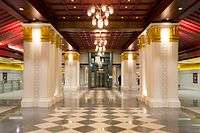
%2C_June_2016.jpg)

The 27 km Blue Line extension will form a quasi circle line (loop). It consists of 19 stations (4 underground stations and 15 elevated stations). (The previous terminus at Bang Sue was extended 1.2 km to the current terminus at Tao Poon as part of the Purple Line project. This opened on 11 August 2017 ).
From Tao Poon station, the line will run elevated west along Pracha Rat Sai 2 rd, cross the Chao Praya river and then run south along the Ratchadapisek inner ring road (Charan Sanit Wong rd) terminating at Tha Phra. From the current Hua Lamphong terminus the line runs 5.4 km underground through Chinatown, under the Chao Praya river to Tha Phra station where it surfaces. It then runs west along Phetkasem road to Lak Song.
The project is divided into 5 contracts:
| Contract | Notes | Kilometre |
|---|---|---|
| 1 | Hua Lamphong to Sanam Chai (2 stations underground, Bt11.65 Billion, contractor ITD) | 2.8 km |
| 2 | Sanam Chai to Tha Phra (2 stations underground, Bt10.82B, contractor CK) | 2.6 km |
| 3 | Tao Poon to Tha Phra (8 stations elevated, Bt11.40B, contractor SH-Unique Joint venture) | 11 km |
| 4 | Tha Phra to Lak Song (7 stations elevated, plus a park-and-ride venue and maintenance yard, Bt13.43B, contractor STEC) | 10.5 km |
| 5 | Rolling stock and systems, Bt5.17 Billion, contractor CK. | |
Construction Progress
Construction commenced in mid-2011 for a scheduled 2016 opening. As of July 2014, civil works progress was 52% done.[11] By October 2014, civil works were 63.75% done. As of January 2017, civil works were 89.16% done.[12] As of 31 December 2017, the progress of civil works construction was at 97.52% according to the MRTA [13] As of the end of April 2018, the MRTA stated that civil works progress had advanced to 63.27%. [14]
In August, 2017, BEM awarded the automatic fare collection ticket for the extension to Thales which will install its TransCity system. [15]The contract also includes ongoing training and future support. In September 2017, BEM announced that Siemens and ST Electronics Thailand were awarded the contract (Contract 5) to supply, install and maintain the E&S systems systems, install station Platform Screen Doors and fit out the depot. Siemens also will supply 35 sets of rolling stock. [16]
The first section of the Blue Line extension from Hua Lamphong – Tha Phra – Lak Song is expected to open on 12 August 2019 with the full extension open by April 2020.[17]
New Rolling stock order
In September 2017, BEM contracted Siemens to supply 35 sets (3 cars) of Siemens Inspiro rolling stock and provide maintenance for 10 years, a contract worth 20 billion baht. The first batch of 3 sets of the new trains will be delivered in late 2018, the second batch of 15 sets will arrive by early 2019 and the last batch of 17 sets will be delivered in late 2019. [18] The fleet will be built in the Siemens plant in Vienna.
Future extension
West: Phutthamonthon Sai 4 Extension
Since 2011, there were requests from residents to extend the line further from Lak Song west to the Phutthamonthon area. The MRTA has indicated a willingness to undertake this extension. In July 2014, the MRTA submitted a request for 84 million baht to complete a route survey for a 7.8 km extension from Lak Song to Phutthamonthon Sai 4.[19] In late March 2017, the Transport Ministry stated that this 7.8 km extension would be submitted to Cabinet for approval in April 2017. The expected timeframe was for construction to commence in the 4th quarter of 2017.[20]. However, the tender has been delayed until 2018.
South: Tha Phra south?
There is future potential and contingency for the Blue Line to be extended further south from Tha Phra along the inner ring road (Ratchadapisek rd) to provide interchange with the SRT Dark Red line, MRT Purple Line and future BMA Grey line Monorail. However, this is not part of current OTP plans and would only be considered in the long term future.
See also
References
- 1 2 "11 สิงหาคนกรุงเดินทางไร้รอยต่อ เปิดส่วนต่อขยายรถไฟฟ้าสายสีม่วง". ไทยรัฐฉบับพิมพ์. 23 June 2017. Retrieved 23 June 2017.
- 1 2 "ทอดพระเนตรศูนย์ควมคุมการปฏิบัติการรถไฟฟ้ามหานคร ซึ่งตั้งอยู่บริเวณเขตหัวยขวาง - Ourking". Ourking (in Thai). 2004-07-03. Retrieved 2017-04-14.
- ↑ "รถไฟฟ้าสายสีน้ำเงิน อุโมงค์ลอดใต้แม่น้ำเจ้าพระยา" [Blue Line Tunnel under the river]. Voice TV21 (in Thai). 3 February 2015.
- ↑ "Blue Line add-on ahead of schedule". Bangkok Post. 9 August 2018.
- ↑ "Mass Rapid Transit Authority of Thailand". mrta.co.th. Retrieved 2017-04-14.
- ↑ "Financial Summary of the Consolidated Financial Statements of Bangkok Expressway and Metro Public Company Limited and its Subsidiaries" (PDF). 2017.
- ↑ "BEM to buy 35 more Blue Line trains". Bangkok Post. Bangkok. 15 September 2017.
- ↑ "Bangkok's first underground metro open". International Railway Journal. findarticles.com. July 2004. Retrieved 2008-08-30.
- 1 2 www.prachachat.net/ (6 July 2018). “ช.การช่าง” เร่งรถไฟฟ้าสายสีน้ำเงิน 14 ส.ค.ปีหน้าเปิดหวูด “หัวลำโพง-หลักสอง” (in ไทย). Retrieved 6 July 2018.
- ↑ "Thai subway shut for safety probe". BBC News. 17 January 2005. Retrieved 13 May 2010.
- ↑ "คมนาคมตามความคืบหน้ารถไฟฟ้า 10 สาย เร่งสีม่วงเปิดปลายปี'58 ชงคสช.อนุมัติอีก 6 สาย" [Transport under accelerated progress Metro Purple Line 10 opened in late '58. NBC maker. Approved by 6 lines.] (in Thai). 28 July 2014.
- ↑ "เปิดแน่ ส.ค.นี้! ครม.ปลดล็อก "1 สถานี" รฟม.ลุยเซ็นจ้าง BEM ส่วนสีน้ำเงินตลอดสายเปิด มี.ค. 63" (in Thai). 14 February 2017.
- ↑ https://www.mrta.co.th/th/news/information/ความก-าวหน-าการก-อสร-างรถไฟฟ-า-ณ-31-ธ-นวาคม-2560/. MRTA Press, 16 January 2018
- ↑ https://www.mrta.co.th/th/news/information/ความก-าวหน-าการก-อสร-างรถไฟฟ-า-ณ-30-เมษายน-2561/. MRTA Press, 30 April 2018
- ↑ "Thales wins Bangkok metro fare collection contract". International Railway Journal. 23 August 2017.
- ↑ "Siemens consortium wins Bangkok Blue Line extension contract". International Railway Journal. 19 September 2017.
- ↑ "Blue Line maximum ticket cost stays at B42". Bangkok Post. 11 August 2018.
- ↑ "BEM to buy 35 more Blue Line trains". Bangkok Post. Bangkok. 15 September 2017.
- ↑ "ลุ้นคลังไฟเขียวงบรถไฟ-รฟม" [Win No Green Light Railway Company - MRTA]. Than Online (in Thai). 15 July 2014.
- ↑ "Blue Line extension, freeway pends Cabinet approval". The Bangkok Post. Bangkok. 26 March 2017. Retrieved 28 March 2017.
External links
| Wikimedia Commons has media related to MRT Blue Line. |
- "MRTA Blue Line extension website"
- "MRT home page" Official Thai website
